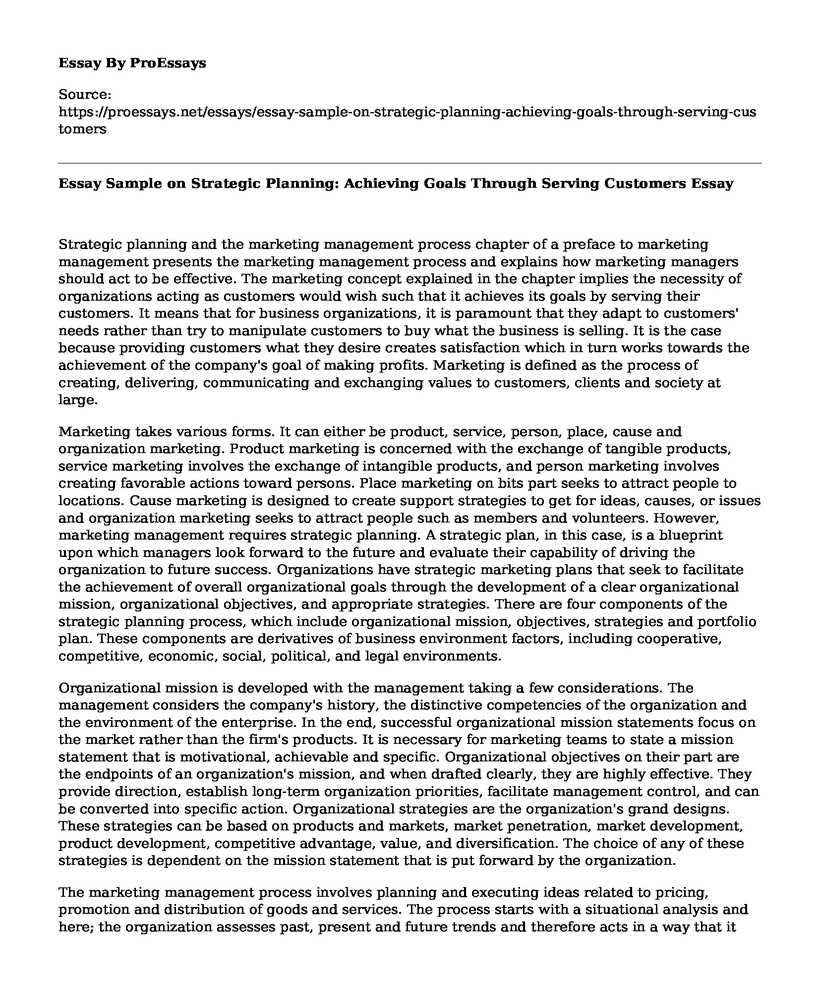Strategic planning and the marketing management process chapter of a preface to marketing management presents the marketing management process and explains how marketing managers should act to be effective. The marketing concept explained in the chapter implies the necessity of organizations acting as customers would wish such that it achieves its goals by serving their customers. It means that for business organizations, it is paramount that they adapt to customers' needs rather than try to manipulate customers to buy what the business is selling. It is the case because providing customers what they desire creates satisfaction which in turn works towards the achievement of the company's goal of making profits. Marketing is defined as the process of creating, delivering, communicating and exchanging values to customers, clients and society at large.
Marketing takes various forms. It can either be product, service, person, place, cause and organization marketing. Product marketing is concerned with the exchange of tangible products, service marketing involves the exchange of intangible products, and person marketing involves creating favorable actions toward persons. Place marketing on bits part seeks to attract people to locations. Cause marketing is designed to create support strategies to get for ideas, causes, or issues and organization marketing seeks to attract people such as members and volunteers. However, marketing management requires strategic planning. A strategic plan, in this case, is a blueprint upon which managers look forward to the future and evaluate their capability of driving the organization to future success. Organizations have strategic marketing plans that seek to facilitate the achievement of overall organizational goals through the development of a clear organizational mission, organizational objectives, and appropriate strategies. There are four components of the strategic planning process, which include organizational mission, objectives, strategies and portfolio plan. These components are derivatives of business environment factors, including cooperative, competitive, economic, social, political, and legal environments.
Organizational mission is developed with the management taking a few considerations. The management considers the company's history, the distinctive competencies of the organization and the environment of the enterprise. In the end, successful organizational mission statements focus on the market rather than the firm's products. It is necessary for marketing teams to state a mission statement that is motivational, achievable and specific. Organizational objectives on their part are the endpoints of an organization's mission, and when drafted clearly, they are highly effective. They provide direction, establish long-term organization priorities, facilitate management control, and can be converted into specific action. Organizational strategies are the organization's grand designs. These strategies can be based on products and markets, market penetration, market development, product development, competitive advantage, value, and diversification. The choice of any of these strategies is dependent on the mission statement that is put forward by the organization.
The marketing management process involves planning and executing ideas related to pricing, promotion and distribution of goods and services. The process starts with a situational analysis and here; the organization assesses past, present and future trends and therefore acts in a way that it will leap maximally in the future. A business must assess the cooperative environment, and this involves assessing the positioning of major stakeholders, including suppliers and resellers. Situational analysis also involves the assessment of the competitive environment, and this primarily involves examining rivalry that is predominant in the industry. The firm also conducts an assessment of the economic environment, and this pertains to looking at the prevailing macroeconomic changes. Social environment assessment is also critical to understanding the general cultural and social traditions, norms, and attitudes. Political environment assessment on its part entails examining the attitudes and reactions of the general public, social and business critics. Nevertheless, any organization engaging in marketing plan must start by establishing objectives, select the target market and develop the marketing mix.
Cite this page
Essay Sample on Strategic Planning: Achieving Goals Through Serving Customers. (2023, Mar 25). Retrieved from https://proessays.net/essays/essay-sample-on-strategic-planning-achieving-goals-through-serving-customers
If you are the original author of this essay and no longer wish to have it published on the ProEssays website, please click below to request its removal:
- DBA: Forms of Business Ownership Essay
- Implementing New Technology in an Organization That Purely Uses Legacy Systems
- Essay Sample on Decision Tree Problems
- Closing the Gender Leadership Gap: How Stereotypes Affect Women Leaders - Essay Sample
- Leadership: Integrity, Trust, Inspiration, Decisions & Rewards - Essay Sample
- Essay Example on Product & Process Innovation: The Essential Link to Industry Life Cycle
- Essay Example on Leadership: An Essential Trait for Achieving Goals & Objectives







